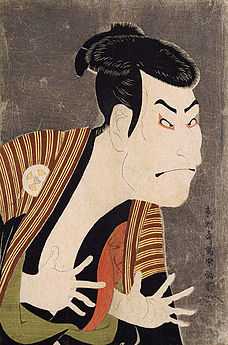Utagawa school

The Utagawa school (歌川派) was a group of Japanese woodblock print artists, founded by Toyoharu. His pupil, Toyokuni I, took over after Toyoharu's death and raised the group to become the most famous and powerful woodblock print school for the remainder of the 19th century.
Hiroshige,[1] Kunisada, Kuniyoshi and Yoshitoshi were Utagawa students. The school became so successful and well known that today more than half of all surviving ukiyo-e prints are from it.
Founder Toyoharu adopted Western-style deep perspective, an innovation in Japanese art. His immediate followers, Utagawa Toyohiro and Utagawa Toyokuni adopted bolder, more sensuous styles than Toyoharu and specialized in different genres — Toyohiro in landscapes and Toyokuni in kabuki actor prints. Later artists in the school specialized in other genres, such as warrior prints and mythic parodies.[2]
Utagawa school and inherited art-names
It was a Japanese custom for successful apprentices to take the names of their masters.[2] In the main Utagawa school, there was a hierarchy of gō (art-names), from the most senior to junior. As each senior person died, the others would move up a step.
The head of the school generally used the gō (and signed his prints) as Toyokuni. When Kunisada I proclaimed himself head of the school (c. 1842), he started signing as Toyokuni, and the next most senior member, Kochoro (a name also previously used by Kunisada I, but not as his chief gō), started signing as Kunisada (Kunisada II, in this case).
The next most senior member after him, in turn, began signing as Kunimasa (Kunimasa IV, in this case), which had been Kochoro's gō before he became Kunisada II. (The original Kunimasa I had been a student of Toyokuni I.)
Following is a list of some members of the main Utagawa school, giving the succession of names, along with the modern numbering of each:
- Toyokuni (I)
- Toyoshige -> Toyokuni (II)
- Kunisada (I) -> Toyokuni (III)
- Kochoro -> Kunimasa (III) -> Kunisada (II) -> Toyokuni (IV)
- Kochoro (II) -> Kunimasa (IV) -> Kunisada (III) -> Toyokuni (V)
See here for a more extensive list.
Two different Toyokuni IIs
An additional complexity is the fact that there are two different artists who are sometimes referred to as Toyokuni II; and similarly for the later-numbered artists called 'Toyokuni'.
The first Toyokuni II was Toyoshige, a mediocre pupil and son-in-law of Toyokuni I who became head of the Utagawa school after Toyokuni I died.
Kunisada I (Toyokuni III) apparently despised Toyoshige, and refused to acknowledge him as head of the Utagawa school. Apparently, this was because he felt that as the best pupil, he should have been named head after the old master died, and was upset with Toyoshige, who apparently got the position because of his family connection.
When Kunisada I took the art-name Toyokuni (c. 1842), he effectively removed Toyokuni II from house history and for a period actually signed as Toyokuni II. However, he is now numbered, Toyokuni III. There are prints which signed Toyokuni II which are by the artist now known as Toyokuni III.
This numbering persisted, so when Kochoro became head of the Utagawa school, he signed as Toyokuni III, although by he would be the fourth Toyokuni. Likewise Kochoro II eventually signed as Toyokuni IV, and is now numbered Toyokuni V.
See also
References
- ↑ Biography of Utagawa Hiroshige in: Forbes, Andrew; Henley, David (2014). 100 Famous Views of Edo. Chiang Mai: Cognoscenti Books. ASIN: B00HR3RHUY
- ↑ 2.0 2.1 Johnson, Ken, "Fleeting Pleasures of Life In Vibrant Woodcut Prints", art review in The New York Times, March 22, 2008. Retrieved March 26, 2008
External links
| Wikimedia Commons has media related to Utagawa Kuniyoshi. |
- Kuniyoshi Project
- Chazen Museum of Art at the University of Wisconsin, Madison, has a collection of more than 4,000 Japanese prints in its E. B. Van Vleck Collection
| ||||||||||||||||||||
